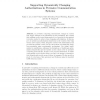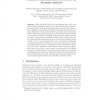SPC
2005
Springer
14 years 6 months ago
2005
Springer
In pervasive computing environments, changes in context may trigger changes in an individual’s access permissions. We contend that existing access control frameworks do not provi...
SPC
2005
Springer
14 years 6 months ago
2005
Springer
Technological progress allows us to equip any mobile phone with new functionalities, such as storing personalized information about its owner and using the corresponding personal p...
SPC
2005
Springer
14 years 6 months ago
2005
Springer
The ephemeral pairing problem requires two or more specific physical nodes in a wireless broadcast network, that do not yet know each other, to establish a short-term relationship...
SPC
2005
Springer
14 years 6 months ago
2005
Springer
As Global Positioning System (GPS) receivers become a common feature in cell phones, personal digital assistants, and automobiles, there is a growing interest in tracking larger us...
SPC
2005
Springer
14 years 6 months ago
2005
Springer
Abstract. Most attempts at analysing secure information flow in programs are based on domain-specific logics. Though computationally feahese approaches suffer from the need for ...
SPC
2005
Springer
14 years 6 months ago
2005
Springer
We develop the theme of an earlier paper [3], namely that security protocols for pervasive computing frequently need to exploit empirical channels and that the latter can be classi...
SPC
2005
Springer
14 years 6 months ago
2005
Springer
Alice first meets Bob in an entertainment shop, then, they wish to share multimedia content, but Do they know what are trustworthy users? How do they share such information in a s...
PERVASIVE
2005
Springer
14 years 6 months ago
2005
Springer
Pervasive computing environments will combine everyday physical spaces with network aware devices and services; hence providing computing behaviour that is much more entwined with...
PERVASIVE
2005
Springer
14 years 6 months ago
2005
Springer
Abstract. Embedded assessment leverages the capabilities of pervasive computing to advance early detection of health conditions. In this approach, technologies embedded in the home...
PERVASIVE
2005
Springer
14 years 6 months ago
2005
Springer
Audio location is a technique for performing accurate 3D location sensing using off-the-shelf audio hardware. The use of off-the-shelf hardware allows audio location deployment to ...



